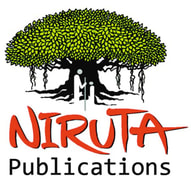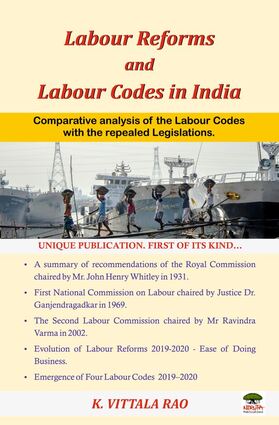|
K. Vittala Rao Pages : 456 PREFACE Labour Reforms, a buzz word is most popular amongst Central and State Governments, the Ministries, Industrialists, Economists, Trade Unions, Workers , Students and Faculty of Management Schools, Law Schools, Research Foundations, and General Public. It is well known that Labour Reforms are aimed at industrial and economic growth, up-liftment of the living standards of all, in particular, industrial employees, generation of employment and the like. India, being highly conscious in developing the Country to the level in Global Market, deep involvement in uplifting the Employees, welfare of families, foresighted targets of employment to the members of the Families, Three Labour Commissions at the National Level were constituted chaired by eminent personalities, highly qualified and experienced, from 1931. The Royal Commission under the Chairmanship of Mr. John Henry Whitley in 1931, First National Commission on Labour Chaired by Justice Dr. Ganjendragadkar in 1969 and the Second Labour Commission chaired by Mr. RavindraVarma in 2002. All the three Commissions have carried out a massive study, collection and collating the data, statistics, survey reports, holding conventions and conferences with all the stake holders and submitted their reports to the Government. Each report is an eye opener to one and all which must be read by all. Three reports are highly voluminous totalling 3071 pages. These three reports provide an impetus in understanding “Industrial Jurisprudence”. The professionals in the area of Human Resources, Legal, and Members of Faculty in all Management Schools and Law schools, the course study will be incomplete without reading all these three reports of Commission. I am sure everyone of you agree that a supplemental reading & study & debate on the following: National Labour Laws Association, for instance, undertook a project (in 1989) National Planning Committee - ‘Plan of economic development for India.’ A Committee to draw up an economic programme Chaired by Pundit Jawaharlal Nehru. Industrial Policy Resolution, 1948, Industrial Policy Resolution, 1956, Monopolies Commission, 1964, Industrial Licensing Policy Inquiry Committee 1969, Industrial Policy Statement, 1973 & 1977, S.P Gupta Committee which was appointed by the Planning Commission submitted a report on the development of small-scale enterprises, 1999, Task Force on Employment Opportunities under five year plans, Indian Labour Code 1999 (draft) prepared by the National Labour Law Association, The Ramanujam Committee, 2014, The Sanat Mehta Committee, A Task Force on Social Security (headed by Shri S.K.Wadhawan) constituted by the Government of India to work out modalities for such integration and unification of ESI scheme, EPF and pension schemes and other Central social security schemes, Bhoothlingam Committee, 1977, the National Commission on Rural Labour constituted under the chairmanship of Dr. C. H. Hanumanth Rao. 1991, National Commission on “Self Employed Women and Women in the Informal Sector” was appointed with Mrs.Ela Bhatt, 1987 as the Chairperson and so on. A detailed study of the three reports of Commissions will be massive and time consuming one. And hence, I considered attempting to summarise these three reports keeping in view of all essentials and preparing a small handbook which can be read by one and all. I consider this handbook be useful to, students and faculty at large, Human Resource & Legal personnel. Secondly, it is the foremost importance that all of us, from the point of view of appreciating the upcoming Labour Codes-Ease to do Business. A combined study of this handbook along with the Four Labour Codes, one will be able to conceptually be adopted effectively. All the Four Labour Codes have been drafted based on the Bills prepared and annexed to the Second Labour Commission, 2002 and also various inputs have been borrowed from previous Commissions/Committees, including the Royal Commission, 1931 and First Labour Commission, 1969. It may be of interest to note that various Committees and Commissions as detailed above, certain key points in them also have been borrowed in preparing the upcoming Labour Codes. Those who are interested in enhancing their competencies in the field of Labour Law, I strongly urge them to read & study all the connected documents as mentioned above. I have attempted to concise the three Reports of Commissions to the best of my ability & knowledge. Hence, this handbook equipped with summarised and comparative presentation of all the Four Codes for a quick glance It may not be out of place to mention that a Single Hand Book containing the captured valid ingredients of all the three reports of Commissions along with the Four Labour Codes will be very useful and first of its kind. I am sure, this hand book will be easily readable and understand the concepts. Most of the inputs including data & statistics have been borrowed from the reports. The certain comments mentioned therein are purely my personal views. K.Vittala Rao President, KVR Management Services Legal & Management Consultancy, Bangalore.
0 Comments
Leave a Reply. |
50,000 HR PROFESSIONALS ARE CONNECTED THROUGH OUR NIRATHANKA HR GROUPS.
YOU CAN ALSO JOIN AND PARTICIPATE IN OUR GROUP DISCUSSIONS. Archives
July 2022
Categories
All
|
||||||
SITE MAP
SiteTRAININGJOB |
HR SERVICESOTHER SERVICESnIRATHANKA CITIZENS CONNECT |
NIRATHANKAPOSHOUR OTHER WEBSITESSubscribe |
MHR LEARNING ACADEMY
50,000 HR AND SOCIAL WORK PROFESSIONALS ARE CONNECTED THROUGH OUR NIRATHANKA HR GROUPS.
YOU CAN ALSO JOIN AND PARTICIPATE IN OUR GROUP DISCUSSIONS.
YOU CAN ALSO JOIN AND PARTICIPATE IN OUR GROUP DISCUSSIONS.
|
|



 RSS Feed
RSS Feed





